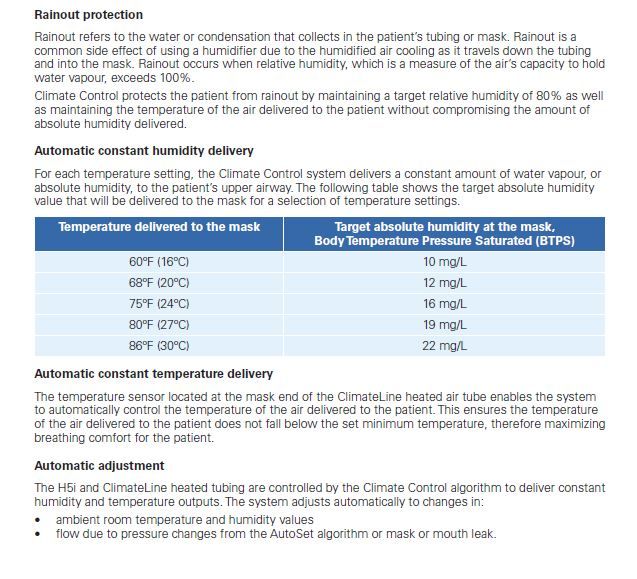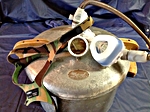Pugsy wrote:Slartybartfast wrote:But that is, in fact, what the table is showing. Those figures are for absolute humidity at different temperatures. They all convert to 80% RH. So the statement that the H5i humidifier and Climateline delivers a constant 80% RH to the mask regardless of temperature is correct. The 44 mg/L figure is saturation, or 100% RH, but only at 99F/37C body temperature.
How can it maintain constant 80% humidity at my house with a temp of 84 degrees and/or a temp of 72 degrees or 68 degrees?
I don't see how it can do that.
What if someone doesn't want or need 80%? Who says that 80% is what the whole world needs and all we need to do is alter temp to our comfort?
What about the clinical manual statement that I circled earlier that says it maintains a
" constant absolute humidity (based on temperature setting)" ?
I don't mean to be argumentative but I just don't see it being able to give everyone 80% at all temperatures.
My own past experience with lower temps on the climateline system in automatic mode tells me that it dried my nasal mucosa out big time. It was not a nice result.
Great discussion! No argument here at all. The problem is the distinction between the term absolute humidity and relative humidity.
Absolute humidity (the right hand column in your table) is the amount of water held by a sample of air. It's like saying a quart jar contains a 50 grams of water. Notice that mention of temperature is conspicuously absent.
Relative humidity is the amount of water held in a sample of air, expressed as a percentage of the total amount of water that sample of air is capable of holding
at a given temperature. Or, using the jar analogy, it's a measure of how much water is held in a quart jar expressed as a percentage of the total capacity of the jar. In this case it's a rather odd jar, because the jar gets bigger when it's warm, and smaller when it's cold.
When you take absolute humidity (right hand column) and correct it for the capacity of air at a given temperature (left hand column) to hold moisture, you have relative humidity. And when you do the conversion, all the figures in the table convert to 80% RH. The capacity of air to hold water rises as temperature rises.
To answer your question, "How can it maintain constant 80% humidity at my house with a temp of 84 degrees and/or a temp of 72 degrees or 68 degrees?"
There is a temperature sensor measuring the air entering the S9. Another sensor measures the water temperature in the humidifier reservoir. A third sensor measures the temperature at the far end of the hose. And a flow sensor measures the rate of airflow through the system. The H5i calculates how much heat to supply to the water in the reservoir in order to force enough water to evaporate into the airstream in order to maintain 80% RH based on ambient temperature. It's really a pretty slick setup.
"What if someone doesn't want or need 80%? Who says that 80% is what the whole world needs and all we need to do is alter temp to our comfort?" Fair question. 80% is used only as a default setting. In that case you can go into manual mode and control the reservoir temperature and air temperature separately and achieve whatever level of humidity you like. But I don't think there is the option of dialing in, for example 75% RH or 50% RH. That would be an easy upgrade for Resmed to make, but it's not a current feature as far as I know.
"What about the clinical manual statement that I circled earlier that says it maintains a 'constant absolute humidity (based on temperature setting)?'" Remember what I said earlier. Relative humidity is absolute humidity at a given temperature. The statement "...absolute humidity (based on temperature setting)" is a clumsy way of saying, simply, "relative humidity."
"My own past experience with lower temps on the climateline system in automatic mode tells me that it dried my nasal mucosa out big time. It was not a nice result."
Up to now, we've been talking physics. Temperature, vapor pressure, evaporation rate. Your question touches on physiology. As moisture evaporates from the tissues in the airway, they are cooled, and the capillaries in the surface layers contract, limiting the amount of blood flow, and thus, moisture, available to maintain a humid environment in your sinuses. So your nose dries out and you feel awful. Turn the temperature up and the warmer air causes the capillaries to dilate which provides more moisture. The higher the relative humidity of the incoming air, the less the tissues will be dried. So 80% RH or higher is a reasonable level to set as a default. If they set it higher, the risk of rainout in the connector hose and mask will rise.
While you've got me going, there's a phenomenon related to the vapor pressure deficit I mentioned in another post that's also at work that runs counter everything I just said. The rate of evaporation from a wet surface into 60 F/80% RH air is slower than the evaporation rate into 80F/80% RH air. Clothes hung on a clothesline dry faster on an 80F day than they do on a 60F day, even though the relative humidity is 80% on both days because the evaporation rate increases more rapidly with increasing temperature.
However, in this case, physiology trumps vapor pressure deficit.











